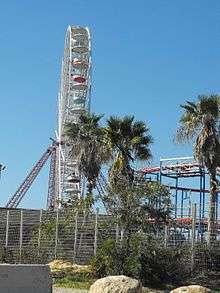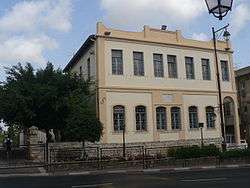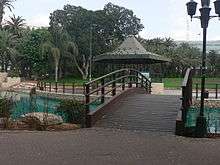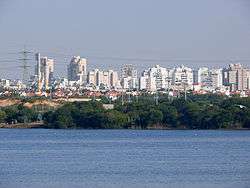Rishon LeZion
Rishon LeZion
| |||
|---|---|---|---|
| Hebrew transcription(s) | |||
| • ISO 259 | Riˀšon l Çiyon | ||
| • Translit. | Rishon LeTziyon | ||
| • Also spelled | Rishon LeZiyyon (official) | ||
|
Rishon LeZion skyline and lake | |||
| |||
 Rishon LeZion | |||
| Coordinates: 31°57′N 34°48′E / 31.950°N 34.800°ECoordinates: 31°57′N 34°48′E / 31.950°N 34.800°E | |||
| Country |
| ||
| District | Central | ||
| Founded | 1882 | ||
| Government | |||
| • Type | City (from 1950) | ||
| • Mayor | Dov Tzur | ||
| Area | |||
| • Total | 58,704 dunams (58.704 km2 or 22.666 sq mi) | ||
| Population (2015)[1] | |||
| • Total | 243,973 | ||
| Name meaning | First to Zion | ||

Rishon LeZion (Hebrew: רִאשׁוֹן לְצִיּוֹן ![]() (audio) , lit. First to Zion) is the fourth-largest city in Israel, located along the central Israeli coastal plain 8 km (5 mi) south of Tel Aviv. It is part of the Gush Dan metropolitan area.
(audio) , lit. First to Zion) is the fourth-largest city in Israel, located along the central Israeli coastal plain 8 km (5 mi) south of Tel Aviv. It is part of the Gush Dan metropolitan area.
Founded in 1882 by Jewish immigrants from Russian Empire, it was the second Jewish farm settlement established in The land of Israel in the 19th century, after Petah Tikva. In 2015 it had a population of 243,973.
Etymology
The name Rishon LeZion is derived from a biblical verse: "First to Zion are they, and I shall give herald to Jerusalem" (Hebrew: ראשון לציון הנה הינם, ולירושלים מבשר אתן) (Isaiah 41:27) and literally translates as "First to Zion".
History
Rishon LeZion was founded on July 31, 1882, by ten Hovevei Zion pioneers from Kharkiv, Ukraine (then the Russian Empire) headed by Zalman David Levontin. Reuven Yudalevich was also a member of the group. The pioneers purchased 835 acres (337.91 ha) of land southeast of present-day Tel Aviv, part of the townland of the Arab village of Ayun Kara (literally 'fountain of the crier').[2][3] Ayun Kara was the scene of a bloody battle between Turkish and New Zealand troops on November 14, 1917.[4] Local citizens carried the wounded to a hospital in Rishon.[5] A stone cenotaph was erected by the people of Rishon LeZion to the memory of the New Zealanders who fell that day, but it has since been destroyed.[6][7]
The founders faced numerous difficulties. The soil was sandy, water was scarce and the settlers had no agricultural experience. After a well was dug and more pioneers arrived – the Biluim – the colony slowly took shape. Notable members of this group include Fani Belkind, Israel Belkind, Shimshon Belkind, Yoel Drubin, Dr. Haim Hissin, and David Yudilovich. When Baron Edmond James de Rothschild took over, sending in his administrators, major progress was made in the spheres of agriculture, citrus and viticulture. Under Rothschild's patronage, the Carmel-Mizrahi Winery was established in 1886.

David Ben-Gurion was head of workers' union at the winery before later becoming Israel's first Prime Minister. The first Hebrew school in the country opened in Rishon LeZion in 1886.Dov Lubman Haviv taught there and Mordechai Lubman Haviv was an educational inspector. Eliezer Ben-Yehuda, known as the father of modern Hebrew, was a teacher in Rishon LeZion. In 1890, Rishon LeZion had a population of 359. Five years later, the figure had risen to 380, and by 1900, to 526. In 1911, 4,000 dunams of land in Rishon LeZion were planted with grapes and 254 dunams with other fruit orchards.[8]
Development was hindered by the lack of a water source. Baron Rothschild brought in experts who located water at 42 meters below ground. The groundwater table in the area was found to be uneven and wells were mostly constructed at between 20 and 25 meters in depth. Orchards were then developed around the settlement, and by the late 1920s the city developed a burgeoning citrus industry.[8]
In 1924 the British Army contracted the Palestine Electric Company for wired electric power. The contract allowed the Electric Company to extend the grid beyond the original geographical limits that had been projected by the concession it was given. The high-tension line that exceeded the limits of the original concession ran along some major towns and agricultural settlements, offering extended connections to the Jewish settlements of Rishon Le-Zion, Nes-Ziona and Rehovot (in spite of their proximity to the high-tension line, the Arab towns of Ramleh and Lydda remained unconnected).[9] According to a census conducted in 1922 by the British Mandate authorities, Rishon LeZion had a population of 1,396 inhabitants, consisting of 1,373 Jews and 23 Muslims,[10] increasing in 1931 census to 2525 inhabitants, in 648 houses.[11] Rishon was declared a city in 1950. By 1983 it had a population of 103,000. In 2006, 222,300 people were living in the city. By 2020, the population is expected to reach 315,000.[12] In 2007, the Rishon LeZion Municipality was awarded the Ministry of Interior Prize for Proper Management.[12]
The city may in the future host a new international airport, which will replace Ben-Gurion International Airport and Sde Dov Airport. Under a plan currently being considered, a new international airport will be constructed on a marine platform built two kilometers (1.2 miles) off shore of Rishon LeZion, the terminals and cargo docks will be built onshore near a highway intersection, which will be linked to the airport by fast trains or buses traveling along a pier.[13] In 2016, the Israeli government approved the expansion of Rishon LeZion onto sand dunes west of the city, upon which one of the largest commercial and residential construction projects in the Central District will be built on 1,000 dunams.[14]
Demographics
According to data from the Israel Central Bureau of Statistics as of December 2012, the number of residents in Rishon LeZion is 235,123.[15] Rishon LeZion is one of the fastest-growing cities in Israel, and is third-youngest city in the country, after Jerusalem and Bnei Brak, with 31.1% of the population being children and teenagers, and 61.4% of all residents being aged 40 or under. In addition, the city has attracted significant immigration,[16] including from English-speaking countries.[17] The city's population growth rate is about 5% per year.[18] The predominant majority of the city's residents are Jews.
Economy

Rishon LeZion's main industries today are wine, construction, services and commerce. Factories and workshops are located in the old industrial zone, which has become a popular venue for pubs, dance clubs and restaurants. Industry in the city is largely divided into two industrial centers: the old industrial zone in the north of the city and the new industrial zone in the west of the city.[12]
The two major malls in Rishon LeZion are Rothschild Center in the old downtown center and Gold Mall (Kenyon HaZahav) in the New West district. Companies such as Coca-Cola, Gazit Globe, Volvo and Fiat are expected to open in the Maayan Sorek area.[12] As part of the city's 5-year plan to be completely water-independent,[19] construction of a desalination plant is planned for Rishon, which will produce 3.7 million cubic meters of water per year. The city already hosts the large Shafdan recycling plant.[12]
Local government
Mayors
- Eliakum Ostashinski (1950–51)
- Aryeh Sheftel (1951)
- Moshe Gavin (1952–55)
- Gershon Man Mankov (1955)
- Hana Levin (1955–60)
- Aryeh Sheftel (1960–62)
- Noam Laoner (1962–65)
- Aryeh Sheftel (1965–69)
- Hananya Gibstein (1969–83)
- Meir Nitzan (1983–2008)
- Dov Tzur (2008–present)
Education and culture


Rishon LeZion has twenty-three elementary schools, nine middle schools and twelve high schools. Rishon Lezion's College of Management has a student population of 10,000.[12] Sixty percentage of twelve graders in the city qualify for a matriculation certificate.
Rishon LeZion holds an annual wine festival. The Rishon LeZion Amphitheatre Live Park has hosted overseas artists such as Sting, Mariah Carey, Metallica, Alanis Morissette, alt-J, Megadeth, Deep Purple, Avicii, Jason Derulo, Wiz Khalifa and Sean Paul. The city has a municipal zoo, an amusement park (Superland), and a beach promenade. Heychal HaTarbut (Hall of Culture) is a venue for classical concerts, theatre performances and cultural events. It has a larger theatre for shows and two smaller ones for artistic workshops. The Israel Symphony Orchestra Rishon LeZion, has participated in music festivals all over the world. It was awarded the ACUM prize in 1991.
In honor of Jewish Nobel Prize winners a boardwalk (Tayelet Hatnei Pras Nobel) was built with cenotaphs of the laureates in Rishon LeZion.
Landmarks
Landmarks in Rishon LeZion include the history museum; the Carmel Winery; the administrative center of Edmond James de Rothschild, now a soldiers' memorial; the Great Synagogue; the Well; the old water tower; and Beit Sefer Haviv, the first Hebrew School. "Open Doors" is a holocaust memorial which is a 7 meter high sculpture designed by Filipino artist Luis Lee Jr. was erected in honor and thanks to President Manuel Quezon and the Filipinos who saved over 1,200 Jews from Nazi Germany.[20][21]
Geography
Rishon LeZion is located on the Israeli Mediterranean Coastal Plain and the northern Shephelah. The city sees the majority of its annual 800 mm (31 in) of precipitation between the months of October and March.
| Climate data for Rishon LeZion | |||||||||||||
|---|---|---|---|---|---|---|---|---|---|---|---|---|---|
| Month | Jan | Feb | Mar | Apr | May | Jun | Jul | Aug | Sep | Oct | Nov | Dec | Year |
| Average high °C (°F) | 17.8 (64.0) |
18.4 (65.8) |
21.3 (69.8) |
25.9 (76.3) |
27.9 (80.4) |
29.2 (84.6) |
30.6 (87.1) |
30.5 (88.0) |
28.8 (86.2) |
25.2 (82.2) |
20.1 (75.4) |
18.5 (67.1) |
24.52 (77.24) |
| Average low °C (°F) | 7.7 (44.1) |
7.9 (44.4) |
9.5 (47.3) |
12.5 (51.8) |
15.7 (56.7) |
18.1 (62.8) |
20.6 (67.3) |
19.8 (68.0) |
17.3 (64.9) |
12.2 (59.0) |
9.4 (52.0) |
8.2 (46.8) |
13.24 (55.43) |
| Average precipitation mm (inches) | 244.7 (9.634) |
108.9 (4.287) |
61.4 (2.417) |
25.3 (0.996) |
3.5 (0.138) |
0 (0) |
0 (0) |
0 (0) |
2.1 (0.083) |
47.9 (1.886) |
73.7 (2.902) |
236.8 (9.323) |
804.3 (31.666) |
| Source: YR.NO[22] | |||||||||||||
Neighborhoods


Rishon LeZion can be divided into four main quarters: the old city, the eastern housing projects, the northern (old) industrial zone, and Western Rishon LeZion. There is also an industrial zone on the southern tip of the city, next to Gan Sorek.
Old city
The old city of Rishon includes the original neighborhoods, some buildings dating back to Rishon's founding in 1881. This quarter is located in the city center, between and around Herzl and Jabotinsky Streets. It includes the following neighborhoods: Nahalat Yehuda (on the northernmost tip of Rishon); Neve Hillel; Bnot Hayil; Abramovich; Katzenelson; Remez (Giv'at Levinson), on the southwestern tip of old Rishon; Rishonim (Gan Nahum), to the east of Remez
Shikunei HaMizrah
The Eastern Housing Projects (Hebrew: שיכוני המזרח Shikunei HaMizrah) was Rishon's quick expansion to the east. It is dominated by the housing projects (shikunim) there, in the Shikunei HaMizrah neighborhood itself. The eastern projects stopped developing when they reached the fences of the Tzrifin military base. When and if Tzrifin is sold to private contractors as planned, this quarter is expected to expand significantly with new lucrative housing projects. Other smaller neighborhoods include Revivim, Kidmat Rishon, Ne'urim, Rambam, Neve Hadarim, HaShomer, Kfar Arye, Mishor HaNof and Kiryat Simha.
Old industrial zone
The industrial zones in Rishon LeZion are called Mabat, an abbreviation for Miskhar, Bilui VeTa'asiya (Commerce, Pastime and Industry). The northern zone is the oldest and original industrial zone, once full of light industry and glass factories. Today, it is known for its prolific nightlife.
West Rishon

West Rishon LeZion is the conglomeration of the new neighborhoods of the city, built in the 1980s and 90s. The west also has higher land value because of its relative proximity to the Mediterranean Sea. It includes the entire city west of Tzahal Road. The quarter includes the new industrial zone (Western Mabat), and a number of residential neighborhoods: Neve Eliyahu (or Ramat Eliyahu), Ne'ot Shikma, Neve Dekalim, Neve Hof (or Pueblo Español), Neve Yam, Kiryat Rishon, Kiryat Cramim, Kiryat Ganim, Ne'ot Ashalim, Kiryat Hatanei Pras Nobel (lit Nobel Prize Laureates' Town)
Sports
Rishon LeZion is known for its achievements in handball and chess. In handball, Hapoel Rishon LeZion and Maccabi Rishon LeZion dominate the handball league. Hapoel has won more than seven domestic championships and cups in a row, with stars like goalkeeper Vladimir Zaikman and field-players Idan Maimon and Dudi Balsar. Its biggest rival, Maccabi took the championship title from Hapoel in 2005/06. Handball is also a dominant sport in Rishon LeZion high schools. The Amit Amal high school handball team has won the world championship several times.
In chess, the Rishon LeZion Chess Club, founded in 1939, is one of the leading clubs in Israel, in senior, women and youth leagues. Israeli grandmasters such as Boris Alterman play for Rishon. World champion Garry Kasparov was a former member.
Hapoel Rishon LeZion is the major football club, currently playing in the second tier, although the club played in the past in the top division, even as recently as 2011–12. The club also appeared in two cup finals, in 1946 and in 1996 and won the 2012–13 Toto Cup Leumit. Other active football teams are Moadon Sport Shikun HaMizrah (playing in Liga Alef), Hapoel Nahalat Yehuda (playing in Liga Bet), and Moadon Sport Rishon LeZion (playing in Liga Gimel). Other football clubs previously played in the city, such as Maccabi Rishon Lezion, which played at the top division during the 1940s and the two seasons after the Israeli Declaration of Independence, as well as smaller clubs which played in the lower tiers, such as Beitar Rishon LeZion, Hapoel Bnei Zion and Hapoel HaMegabesh Rishon LeZion.
The main football stadium in Rishon LeZion is the 6,000-seats Haberfeld Stadium, which hosts matches of Hapoel Rishon LeZion. Other, smaller stadiums, are located in Shikun Hamizrah, in Nahlat Yehuda and in the Superland complex.
The Maccabi Rishon LeZion basketball team is a long-time member of Ligat HaAl, the top division. The team plays at Bet Maccabi Arena, which seats 2,500. Maccabi The team was a rival to Israel's top club and European champion, Maccabi Tel Aviv in the 1990s.
In the city also is home to the new 3,000-seats Athletics Municipal Stadium, which was built between 2001 and 2013, with the intention to host international athletics competitions.
Transportation
Rishon LeZion can be accessed by road from several major highways. Public transportation includes bus, train and share taxi.
Rail transport

The Rishon LeZion HaRishonim Railway Station is located to the south of the city center, in the middle of HaRishonim Interchange, at the intersection of the new Highway 431 and the Rishon LeZion – Ness Ziona road. There are direct trains from the HaRishonim Railway Station to Tel Aviv, Lod, Bnei Brak, Petah Tikva, Rosh HaAyin, Hod HaSharon and Kfar Saba. All stations of Israel Railways can be accessed using the transfer stations at Tel Aviv and Lod.
The Rishon LeZion Moshe Dayan Railway Station is in the western part of the city, situated on the new rail line from Tel Aviv to Ashdod via Moshe Dayan station and Yavne (West). While the link north to Tel Aviv is operational, the railway from Moshe Dayan to Yavne is currently under construction and is expected to be completed in 2012 and from Yavne to Ashdod in 2013. There are future long-range plans for some day connecting the Rishonim station with Moshe Dayan station, while constructing a couple of additional railway stations in between them.
Bus transport
The bus companies serving intercity lines in Rishon LeZion are: Egged, Dan, Afikim, Metropoline, and Kavim. Rishon LeZion has an intracity bus network operated by Egged and Dan. Most lines are metropolitan, continuing to Bat Yam, Holon, Tel Aviv and Jaffa. The bus lines are augmented by share taxis operated by Moniyot HaIr.
Notable residents
- Yaacov Agam (born 1928), sculptor and artist
- Zohar Argov (1955–87), singer
- Shoshana Damari (1923–2006), singer
- Mei Finegold singer
- Shai Gabso, singer
- Gideon Gechtman, sculptor
- Boris Gelfand (born 1968), chess grandmaster
- Tal Ben Haim, football/soccer player
- Ya'akov Hodorov, goalkeeper
- Nitzan Horowitz, politician
- Ziv Kalontarov (born 1997), European champion swimmer
- Anastassia Michaeli, television journalist, presenter, politician
- Yagutil Mishiev (born 1927), author
- Muki singer
- Ophir Pines-Paz, politician
- Sefi Rivlin, actor and comedian
- Bat-Sheva Zeisler, singer
- Shlomo Molla, politician
International relations
Twin towns — Sister cities
Rishon LeZion is twinned with:
Africa
Asia
|
Europe | North America
|
During the Gulf War in 1991, the mayor of Münster, Germany, made a surprise visit to Rishon LeZion. According to Haaretz, he felt he could not sit quietly at home while missiles were falling on his sister city. Throughout the war, he stayed at the home of Rishon LeZion mayor Meir Nitzan and accompanied him on visits to sites hit by missiles.[26]
In 2009 a memorial was erected in Rishon Le-Zion to the 10,000 German and Austrian Jews who found refuge in the Philippines during the Shoah.[27]
References
- ↑ "List of localities, in Alphabetical order" (PDF). Israel Central Bureau of Statistics. Retrieved 16 October 2016.
- ↑ "History of Rishon LeZion". Rishon LeZion municipality. Retrieved 4 February 2014.
- ↑ "Definition of enhakkore". Onlinedictionary.datasegment.com. Retrieved September 24, 2011.
- ↑ "The Battle of Ayun Kara, Palestine, 14 November 1917". Desert-column.phpbb3now.com. Retrieved September 24, 2011.
- ↑ "Ayun Kara New Zealand Mounted Rifles". nzmr.org.
- ↑ "Haswell-Hugh-Gordon-World-War-I,-1914-1918". Auckland War Memorial Museum. Retrieved September 24, 2011.
- ↑ "Ayun Kara New Zealand Mounted Rifles". Nzmr.org. Retrieved September 24, 2011.
- 1 2 Karlinsky, Nahum; Greenwood, Naftali (2005). California Dreaming: Ideology, Society, and Technology in the Citrus. SUNY Press. p. 54. ISBN 0-7914-6527-6. Retrieved April 5, 2008.
- ↑ Shamir, Ronen (2013). Current Flow: The Electrification of Palestine. Stanford University Press. ISBN 978-0804787062.
- ↑
- ↑ Mills, 1932, p. 23
- 1 2 3 4 5 6 "Municipality of Rishon LeZion Profile". Israel's Largest Enterprises 2008. Dun's 100. Retrieved April 5, 2008.
- ↑ Ido Efrati (September 1, 2012). "Airport at sea, or castle in the air?". Haaretz. Retrieved 4 February 2014.
- ↑ http://www.globes.co.il/en/article-huge-rishon-lezion-project-given-green-light-1001108894
- ↑ "Locality File" (XLS). Israel Central Bureau of Statistics. 2012. Retrieved October 30, 2013.
- ↑ "עיריית ראשון לציון - דף הבית". rishonlezion.muni.il.
- ↑ Andrew Esensten (November 9, 2012). "Rishon Letzion reaches out to English-speakers". Haaretz. Retrieved 4 February 2014.
- ↑ "עיריית ראשון לציון - דף הבית". rishonlezion.muni.il.
- ↑ Green, Michael (October 16, 2008). "Dig It!". The Jerusalem Post. Retrieved November 23, 2008.
- ↑ Madison Park, CNN (3 February 2015). "How the Philippines saved 1,200 Jews during Holocaust - CNN.com". CNN.
- ↑ "Monument in Israel Honors Filipinos". asianjournalusa.com.
- ↑ "Weather statistics for Rishon LeZion in Central Israel (Israel)". yr.no. Retrieved September 1, 2010.
- ↑ "Miasta Partnerskie Lublina" [Lublin - Partnership Cities] (in Polish). Archived from the original on 2013-01-16. Retrieved 2013-08-07.
- ↑ "Lublin's Partner and Friend Cities: Rishon LeZion". The Municipality of Lublin City. October 1, 1992. Retrieved September 24, 2011.
- ↑ "Portrait of Münster: Die Partnerstädte". Stadt Münster. Archived from the original on 2013-05-09. Retrieved 2013-08-07.
- 1 2 Gilad, Moshe (September 6, 2007). "Choose your family". Haaretz. Retrieved February 4, 2014.
- ↑ "German Jews Who Fled To the Philippines Were Saved From Japanese Brutality By Their Swastika Stamped Passports". WAR HISTORY ONLINE. Retrieved November 13, 2015.
External links
| Wikimedia Commons has media related to Rishon LeZion. |
| Wikivoyage has a travel guide for Rishon LeZion. |
- Rishon LeZion City Hall (Hebrew)
- Places to Visit in Rishon LeZion (English)
- Rishon Le-Zion Digital Family Album


